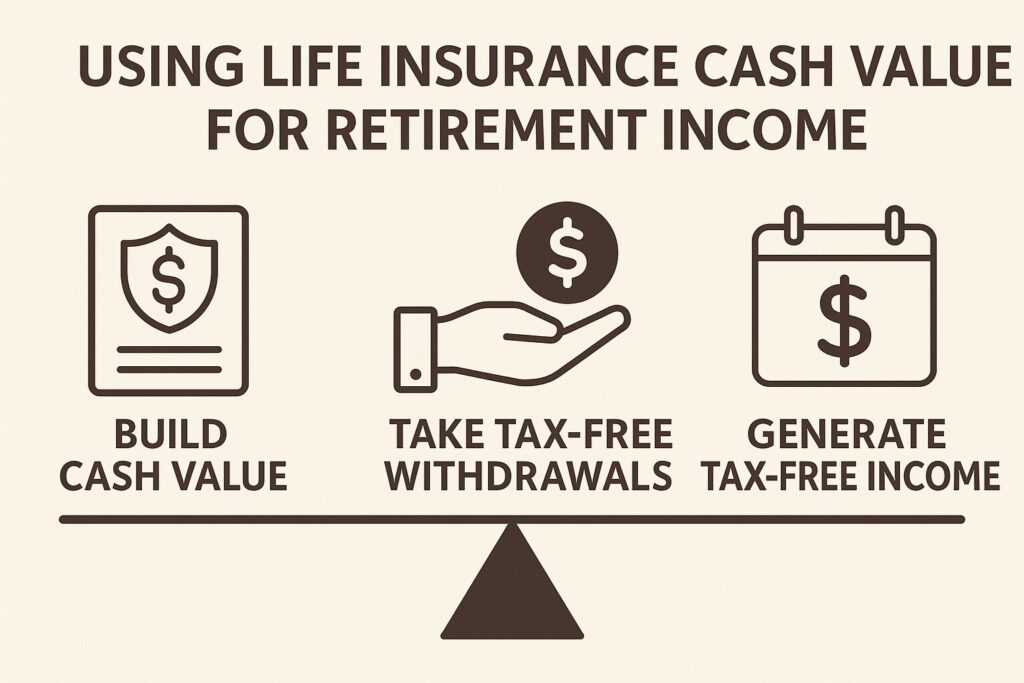
How retirees turn cash value policies into reliable, tax-free income
When people think of life insurance, they often think of it as protection for loved ones. But retirees in the know are using a lesser-known strategy: tapping into the cash value of permanent life insurance to create tax-free income in retirement.
With the right setup, a cash value life insurance policy can provide steady income, preserve your nest egg, reduce taxes, and leave a legacy.
In this post, you’ll learn:
- How policy loans and withdrawals work
- The tax advantages of accessing cash value
- Smart strategies to manage distributions
- And how this approach fits into a safe, well-rounded retirement plan
✅ What Is Cash Value Life Insurance?
Cash value life insurance includes permanent policies like:
- Whole Life
- Indexed Universal Life (IUL)
- Variable Universal Life (VUL)
These policies include a savings component (cash value) that grows over time, tax-deferred. Once you’ve built up a sufficient amount, you can access it in two ways:
- Withdrawals – Tax-free up to the amount you’ve contributed (your cost basis)
- Policy Loans – Tax-free loans backed by your policy’s cash value, with interest
If structured and managed properly, this income can be used without triggering income taxes, RMDs, or affecting Social Security or Medicare costs.
✅ How Tax-Free Policy Loans Work
Here’s a common strategy retirees use:
- Fund the policy heavily during your working years
- Let cash value accumulate and grow over time
- In retirement, borrow against the cash value tax-free
- Pay interest only, or allow the balance to be deducted from your death benefit
Because you’re taking a loan (not a distribution), there’s no income tax. The death benefit remains intact—minus any outstanding loan balance.
This gives you income without touching IRAs, triggering RMDs, or bumping up your tax bracket.
✅ Real-Life Example: Paul’s Tax-Free Paycheck
Paul, a 71-year-old retiree, had accumulated $250,000 in cash value in his whole life policy. Rather than increase his IRA withdrawals (and his tax bill), Paul borrowed $20,000 a year from the policy. His income remained tax-free, and he kept his Social Security untaxed and Medicare premiums low.
“I call it my tax-free paycheck,” he says.
✅ Managing Withdrawals for Tax Advantages
Cash value policies give you tremendous flexibility—but you need a smart withdrawal plan. Here’s how to do it:
1. Withdraw Up to Your Cost Basis First
You can withdraw tax-free up to the total amount you’ve paid in premiums. This is known as your “basis.”
✅ Example: If you’ve paid $80,000 into the policy over time, you can withdraw up to $80,000 without paying taxes.
2. Then Use Policy Loans for Additional Income
Once your withdrawals exceed your basis, switch to policy loans. These loans aren’t considered income and don’t show up on your tax return—so they won’t affect:
- IRMAA (Medicare premium surcharges)
- Social Security taxation
- Your marginal tax bracket
3. Coordinate with Other Income Sources
Use tax-free policy income to reduce pressure on your IRA withdrawals. This helps you:
- Delay RMDs
- Lower overall taxable income
- Avoid triggering capital gains taxes or bumping into a higher tax bracket
4. Avoid a Lapse
Make sure the policy stays in force. If it lapses with an outstanding loan, the loan amount may become taxable. Work with an advisor to monitor cash value and ensure the policy is adequately funded.
✅ Why Retirees Love This Strategy
- Tax-free income
- No RMDs or age restrictions
- No impact on Social Security or Medicare premiums
- Asset protection in many states
- A tax-free death benefit for your heirs
It’s especially useful for retirees looking to reduce taxes, smooth out income, and leave a legacy—all in one tool.
📘 This post is adapted from my book:
The Life Insurance Secret: How to Grow Rich Using Cash Value Life Insurance
Available now on Amazon.com in paperback and eBook formats
Inside, you’ll discover how to:
- Choose the right policy
- Maximize tax-free growth
- Create lifetime income
- Avoid common mistakes
- And use life insurance to build real, lasting wealth
⚠️ Disclaimer
This post is for informational and educational purposes only and does not constitute financial, insurance, or tax advice. Always consult a licensed financial advisor, insurance professional, or tax expert before making financial decisions. The author is not a licensed insurance agent and does not provide personalized recommendations.